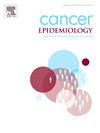20 年来印度东部妇女高危型人类乳头瘤病毒感染、高级别宫颈癌前病变和宫颈癌患病率的时间趋势分析--三项研究的汇总分析
IF 2.4
3区 医学
Q3 ONCOLOGY
引用次数: 0
摘要
宫颈癌仍然是世界范围内妇女癌症相关发病率和死亡率的主要原因,特别是在低收入和中等收入国家。尽管缺乏任何有组织的以人群为基础的筛查规划或HPV疫苗接种,但印度宫颈癌的发病率在过去二十年中有所下降。本研究分析了高危人乳头瘤病毒(hrHPV)患病率和CIN 2 + 检测的趋势,并检查了20多年来印度西孟加拉邦社会人口因素的影响。方法分析2001年至2021年间在西孟加拉邦农村进行的三项宫颈癌筛查研究的数据。采用Hybrid Capture II©(HC II)试验对80,988名30-60岁女性进行筛查。CIN 2 + 检出率按年龄、教育程度和婚姻分层。采用Logistic回归模型确定影响高危HPV阳性和CIN 2 + 患病率的因素。结果在整个研究期间,总体高危HPV阳性率保持相对稳定(5 %),自行采集的样本与提供者采集的样本之间无显著差异。然而,CIN 2 + 的检出率显著下降,从2001-2003年的5.7/1000下降到2018-2021年的2/1000(调整后的优势比[OR]:0.27;95 %置信区间[CI]: 0.12-0.46)。高等教育(OR: 0.64;95 % CI: 0.45-0.88)和延迟结婚年龄(OR: 0.62;95 %CI: 0.31-1(年龄>;21)与较低的CIN 2 + 风险相关。结论研究结果表明,西孟加拉邦CIN 2 + 患病率的下降可归因于教育水平的提高、结婚年龄的推迟、生育率的降低和妇女赋权,这可以解释印度宫颈癌发病率的逐渐下降。然而,印度的宫颈癌发病率仍然高于世卫组织的消除目标。必须加快实施人乳头瘤病毒疫苗接种和加强筛查规划,以维持和加速在消除宫颈癌方面取得进展。本文章由计算机程序翻译,如有差异,请以英文原文为准。
Analysis of time trends of prevalence of high-risk HPV infections, high grade cervical precancer and cervical cancer disease in women from Eastern India over 20 years − Pooled analysis from three studies
Background
Cervical cancer remains a leading cause of cancer related morbidity and mortality among women worldwide, particularly in low-and middle- income countries (LMICs). The incidence of cervical cancer has declined in India over the last two decades despite the lack of any organised population-based screening programme or HPV vaccination. This study analyses the trends in high-risk human papilloma virus (hrHPV) prevalence and CIN 2 + detection and examines the influence of sociodemographic factors in West Bengal, India from over a span of two decades.
Methods
Data from three cervical cancer screening studies conducted in rural West Bengal were analysed between 2001 and 2021. A total of 80,988 women aged 30–60 years were screened using Hybrid Capture II© (HC II) test. Detection rates of CIN 2 + were stratified by age, education and marriage. Logistic regression models were used to identify factors influencing high risk HPV positivity and CIN 2 + prevalence.
Results
The overall high risk HPV positivity rate remained relatively stable (5 %) across the study periods with no significant difference between self-collected and provider collected samples. However, CIN 2 + detection rates declined significantly from 5.7/1000 in 2001-2003 to 2/1000 in 2018–2021 (adjusted odds ratio [OR]:0.27; 95 % confidence interval [CI]:0.12–0.46). Higher education (OR: 0.64; 95 % CI: 0.45–0.88) and delayed age at marriage (OR: 0.62; 95 %CI: 0.31–1 for age>21) were associated with lower CIN 2 + risk.
Conclusion
The findings of the study indicate that the observed decline in CIN 2 + prevalence in West Bengal can be attributed to improved education, delayed age at marriage, reduced fertility rate and women’s empowerment, which can explain the gradual reduction in cervical cancer incidence in India. However, the cervical cancer incidence in India remains above WHO elimination targets. Expedited implementation of HPV vaccination and strengthening screening programmes are necessary to sustain and accelerate progress towards elimination of cervical cancer.
求助全文
通过发布文献求助,成功后即可免费获取论文全文。
去求助
来源期刊

Cancer Epidemiology
医学-肿瘤学
CiteScore
4.50
自引率
3.80%
发文量
200
审稿时长
39 days
期刊介绍:
Cancer Epidemiology is dedicated to increasing understanding about cancer causes, prevention and control. The scope of the journal embraces all aspects of cancer epidemiology including:
• Descriptive epidemiology
• Studies of risk factors for disease initiation, development and prognosis
• Screening and early detection
• Prevention and control
• Methodological issues
The journal publishes original research articles (full length and short reports), systematic reviews and meta-analyses, editorials, commentaries and letters to the editor commenting on previously published research.
 求助内容:
求助内容: 应助结果提醒方式:
应助结果提醒方式:


